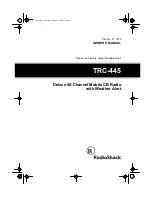
MM-010019-001, Rev. B
59
12.
Compare the wattmeter reading with the RF power output range of
2 watts or less.
Transmit only for as long as needed to take the measurement, then immediately disable
the transmission.
13.
If the wattmeter reading is within the range,
record the value in the appropriate space on the data
collection form near the end of this manual.
If the wattmeter reading is outside the range,
make sure the antenna is consistent with the specified
frequency range of the radio. Recheck all antenna connections, and measure the reverse power again.
If this fails to produce a reading within the range, replace the antenna and repeat the entire antenna
test procedure. Any value exceeding the maximum allowable reflected power value will result in a
diminished RF output signal. If problems persist, contact M/A-COM’s Technical Assistance Center
(see page 16).
14.
Disconnect the coaxial cable jumper and wattmeter.
15.
Permanently connect the cable from the vehicle-mounted 700/800 MHz antenna to the radio’s
antenna cable by mating the two TNC connectors together. Use two pairs of slip-jaw pliers to gently
tighten this connection. Do not over tighten and do not twist either cable.
To prevent RF leakage and ensure peak performance, make sure the RF connectors are
tight, but do not over tighten so connector damage will not occur.
Improper installation of the RF cables may lead not only to poor radio
performance but also to harmful exposure to RF electromagnetic energy.
Testing is complete. The radio is now ready for normal communications.






































